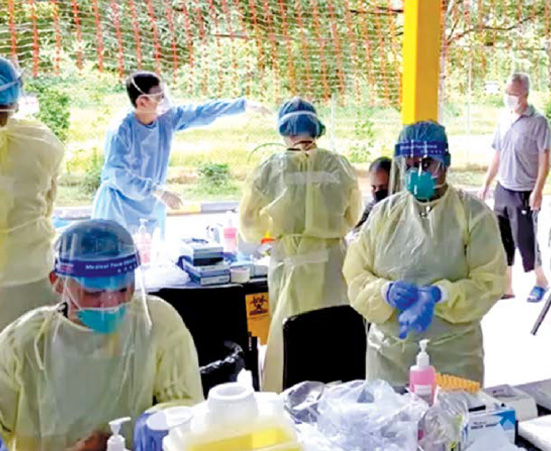Having applied the SAF's Mission Analysis processes to the problem, JTF(A) soon came to a worrying conclusion. It was neither sufficient nor sustainable to merely put out fires as they broke out. It was not enough to get through the “Circuit Breaker” with sufficient essential workers. We had to ensure that Singapore could return to a normal state as soon as possible. This meant releasing as many migrant workers as possible back into the workforce, beyond those already identified as essential workers.
This would require a sustainable housing solution for the migrant workers beyond the immediate needs. The community infrastructure which had been locked up as recovery sites had to be released so that both the economy and society could continue to function as normally as possible. Most importantly, we had to avoid overwhelming the healthcare system.
JTF(A) was juggling two balls - committing resources and manpower to contain the spread of the virus in infected dormitories, while investing equal effort to prevent new clusters from emerging in “clean” dormitories. However, the large number of residents and limited testing capacity soon meant that infections were festering undetected in some dormitories. The demand for Polymerase Chain Reaction (PCR) testing resources quickly far outstripped the supply allocated to JTF(A). The shortage of testing resources meant that the outbreak could well spiral out of control if a solution was not found.
The team returned to the drawing board. Adopting a systems thinking mindset, it mapped out the ecosystem of assets and stakeholders which were both directly and indirectly relevant to the task. This revealed that there were alternative testing resources available at the national level, such as wastewater testing and serology. These were under-utilised because they were relatively less effective in detecting active transmissions. But they could be useful surveillance tools in dormitories where viral transmission was low.
JTF(A) then devised a creative combination of the available testing resources to develop a comprehensive testing regime that could cater to different COVID-19 situations across the dormitories. Those that had more cases were allocated serology tests which could identify recovered and non-infected workers. Dormitories with fewer cases were allocated pooled PCR tests. There was regular testing of wastewater in COVID-free dormitories to provide early warning of contagion.


FAST personnel working alongside healthcare workers to conduct mass testing at a dormitory.
Source: MINDEF
This strategy allowed the JTF(A) to keep a pulse on all dormitories without depleting the limited PCR testing resources. Surges were quickly arrested as they became apparent. This ultimately helped the team to transit from crisis management to crisis resolution. To get to that point required much time to be invested to appreciate the dynamic situation, translate evolving policies into concrete plans, and communicate orders for the deployed forces (FAST, medical and testing teams) to act. It was a demonstration of systems thinking and discipline in executing operations, which are key leadership competencies that the SAF inculcates in every officer, that enabled JTF(A) to look at the problem from a wider perspective and achieve mission success within a matter of months.